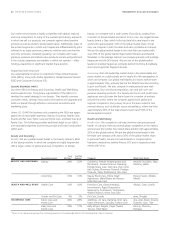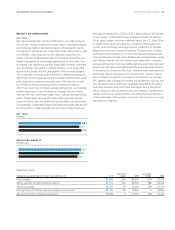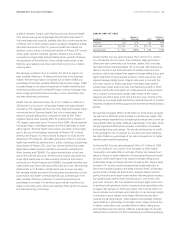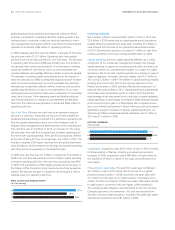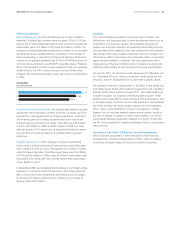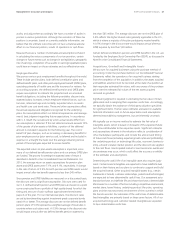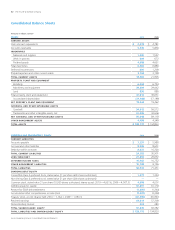Proctor and Gamble 2010 Annual Report Download - page 44
Download and view the complete annual report
Please find page 44 of the 2010 Proctor and Gamble annual report below. You can navigate through the pages in the report by either clicking on the pages listed below, or by using the keyword search tool below to find specific information within the annual report.
42 The Procter & Gamble Company Management’s Discussion and Analysis
Household Care
FABRIC CARE AND HOME CARE
($millions) 2010
Change vs.
Prior Year 2009
Change vs.
Prior Year
Volume n/a +6% n/a -3%
Net sales $23,805 +3% $23,186 -2%
Net earnings $ 3,339 +10% $ 3,032 -11%
Fabric Care and Home Care net sales increased 3% to $23.8billion in
2010 on a 6% increase in unit volume. Pricing reduced net sales by
1% as the impact of price reductions to improve consumer value
were partially offset by price increases taken primarily in developing
regions to offset currency devaluations. Mix lowered net sales by 1%
due mainly to unfavorable geographic mix and a shift toward larger
size products, which have lower than segment average selling prices.
Unfavorable foreign exchange reduced net sales by 1%. Organic sales
grew 4%. Volume increased mid-single digits in both developed and
developing regions. Fabric Care volume grew mid-single digits behind
new product launches, price reductions and incremental merchandis-
ing activity. Global market share of the fabric care category was down
about half a point on a constant currency basis. During 2010, the
Ace laundry brand became the Company’s 23rdbillion-dollar brand.
Home Care volume was up high single digits mainly due to new
product launches, media spending increases and market size expan-
sion. On a constant currency basis, global market share of the home
care category was up about half a point versus 2009. Batteries volume
increased mid-single digits primarily due to growth in Greater China,
price reductions to improve consumer value in North America and
higher demand from business customers.
Net earnings increased 10% to $3.3billion due to higher net sales and
a 90-basis point increase in net earnings margin. Net earnings margin
increased due to higher gross margin and a lower tax rate, partially
offset by an increase in SG&A as a percentage of net sales. Gross
margin increased mainly due to lower commodity costs and manufac-
turing cost savings, while SG&A as a percentage of net sales increased
due to higher marketing spending. The tax rate declined due to a shift
in the geographic mix of earnings to countries with lower statutory
tax rates.
Fabric Care and Home Care net sales were down 2% in 2009 to
$23.2billion on a 3% decline in unit volume. Price increases, taken
primarily to offset higher commodity costs, added 6% to net sales,
while unfavorable foreign exchange reduced net sales by 5%. Organic
sales increased 3%. Fabric Care, Home Care and Batteries unit volume
were each down in both developed and developing regions. Volume in
Fabric Care declined low single digits due to trade inventory reductions
and net market volume share declines following price increases. Lower
shipments of premium-priced Tide and Ariel were only partially offset
by growth of Gain and Downy. Global value share of the fabric care
market was down less than half a point behind declines in U.S. all-
outlet shares of Tide and Downy, partially offset by share growth of
Gain. Home Care volume was down low single digits due to market
contractions and trade inventory reductions. Batteries volume declined
high single digits due to market contractions, trade inventory reduc-
tions and competitive activity, which drove a 1-point market share
decline of general purpose batteries. Net earnings declined 11% to
$3.0billion primarily due to reduced net earnings margin and lower
net sales. Net earnings margin contracted 130 basis points due to a
commodity-driven decline in gross margin, which was partially offset
by price increases and manufacturing cost savings. Lower marketing
spending as a percentage of net sales was largely offset by higher
overhead spending as a percentage of net sales.
In July2010, we acquired Ambi Pur, a leading air care brand with
presence in 80 countries, as well as several toilet care products from
the Sara Lee Corporation for approximately $400million. This business
will be integrated into Home Care and will be reflected in the results
of operations of the Fabric Care and Home Care segment beginning in
fiscal 2011. This acquisition is not expected to have a material impact
on the results of operations for the Company or the reportable segment.
BABY CARE AND FAMILY CARE
($millions) 2010
Change vs.
Prior Year 2009
Change vs.
Prior Year
Volume n/a +7% n/a +1%
Net sales $14,736 +4% $14,103 +1%
Net earnings $ 2,049 +16% $ 1,770 +2%
Baby Care and Family Care net sales grew 4% to $14.7billion in 2010
on 7% volume growth. Pricing was in line with the prior year as the
impact of price increases primarily taken in developing regions to
offset local currency devaluations were offset by price reductions to
improve consumer value. Negative mix reduced net sales by 2% driven
mainly by disproportionate growth of mid-tier product lines, large
count packs and developing regions, all of which have lower than
segment average selling prices. Unfavorable foreign exchange reduced
net sales by 1%. Organic sales increased 5%. Volume grew double
digits in developing regions and mid-single digits in developed regions.
Volume in Baby Care increased high single digits behind incremental
initiative activity, market size expansion and price reductions to improve
consumer value, primarily in CEEMEA. Global share of the baby care
market was up over half a point on a constant currency basis. Volume
in Family Care grew high single digits due to increased merchandising
and initiative activity, market growth and price reductions to improve
consumer value.
Net earnings increased 16% to $2.0billion in 2010 behind net sales
growth and 140 basis points of net earnings margin expansion driven
by higher gross margin, partially offset by higher SG&A as a percentage
of net sales. Gross margin increased mainly due to lower commodity
costs and manufacturing cost savings. SG&A as a percentage of net
sales increased primarily behind incremental marketing investments
and higher foreign currency exchange costs.
Baby Care and Family Care net sales increased 1% to $14.1billion in
2009 on 1% volume growth. Pricing to help recover higher commodity
and energy costs contributed 5% to net sales growth. Unfavorable
foreign exchange reduced net sales by 4%. Negative product mix from


